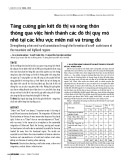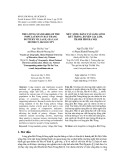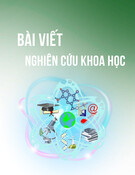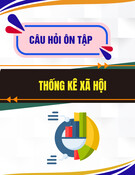
7
International Journal of Management (IJM)
Volume 10, Issue 1, January–February 2019, pp. 7-13, Article ID: IJM_10_01_002
Available online at http://www.iaeme.com/ijm/issues.asp?JType=IJM&VType=10&IType=1
Journal Impact Factor (2019): 9.6780 (Calculated by GISI) www.jifactor.com
ISSN Print: 0976-6502 and ISSN Online: 0976-6510
© IAEME Publication
A STUDY ON THE AWARENESS LEVEL
AMONG CONSUMERS TOWARDS
ENVIRONMENT FRIENDLY CARS WITH
REFERENCE TO INDORE
Neeti Chaturvedi
Assistant Professor,
Sri Cloth Market Institute of Professional Studies Indore, (M.P), India
Dr. Rajendra Singh
Professor, Ex-HOD, Indore Institute of Management & Research, Indore, India
Dr. Ajit Upadhyaya
Professor, HOD (Mktg), Prestige Institute of Management And Research, Indore, India
ABSTRACT
The current environment is having an all pervasive need for the equipment’s which
are non-detrimental to the present ambience. Green automobiles are those that are
having a more environment friendly manifestation. Indian automobile industry in the
current scenario is engaged in the process of providing the type of vehicles that are
having the green concept promoting technology. This paper is an empirical study of
the awareness level among the consumers towards the green automobiles. This paper
would help proclaim a picture of the present mental setup of the masses which would
help the automobile industry visualize the acceptability of the green automobiles. This
paper would also help how far the different technology is preferred among the
consumers.
Keywords: Environment friendly cars.
Cite this Article: Neeti Chaturvedi, Dr. Rajendra Singh and Dr. Ajit Upadhyaya, A
Study On The Awareness Level Among Consumers Towards Environment Friendly
Cars with Reference To Indore. International Journal of Management, 10 (1), 2019,
pp. 7-13. http://www.iaeme.com/ijm/issues.asp?JType=IJM&VType=10&IType=1
1. INTRODUCTION
The Indian car industry has transformed tremendously since the first car rolled out on the
roads of Mumbai in the year 1898. Currently the Indian car industry is the sixth largest in the
world and the automotive industry being one of the largest in the world. The car industry
employs directly or indirectly around six people per car, with an average 24 million vehicles

A Study On The Awareness Level Among Consumers Towards Environment Friendly Cars with
Reference To Indore
http://www.iaeme.com/IJM/index.asp 8 editor@iaeme.com
being produced annually leading to 29 million direct or indirect employment are being
generated all over India. The expansion of Indian car industry is majorly due to a mental setup
of the masses to own a four wheeler in their lifetime; it results in escalation of possession of
cars by the individual. Indian environment is facing critical phase with cities shutting down
their routine schedules out of the polluted environmental situation.
1.1. WHAT IS GREEN MARKETING
Green marketing means any production, distribution and promotion of environment friendly
products. The products that are non-detrimental to the environment and are non-damaging to
the ambience may be stated as green products. Mintu&Lozada (1993) defined green
marketing as the “application of marketing tools to facilitate exchanges that satisfy
organizational and individual goals in such a way that the preservation, protection and
conservation of the physical; environment is upheld.”
“Green or Environmental marketing consists of all activities designed to generate and
facilitate any exchanges intended to satisfy human needs or wants, such that the satisfaction of
these needs and wants occur, with minimal detrimental impact on the natural
environment”.(Polonsky 1994b,2)
1.2. GREEN AUTOMOBILES IN INDIA
Green automobile are the one being amicable towards the environmental combination and that
retain the environment unperturbed. Heavy traffic, congestion on the roads and less use of
highways make India the most suitable place for the electric vehicle, which is saving fuel
through hybrid vehicles. The vehicles in India are more in the idle state and running at a lower
speed as they are facing traffic logging quite frequently. The Indian roads are the more ideal
ones for the electric vehicles as compared to the US or other developed countries. Since there
are more fuel saving in case of Indian traffic, as this study states.(untapped potential of hybrid
cars in India) (by Narayan Lakshman, The Hindu) The Indian roads are a bizarre mode of
transport as compared to the US ones as they are not smooth, have frequent traffic jams
compelling less speed on the part of Indian vehicles. Thus they require a different type of fuel
saving vehicle technology as compared to the one in US.
1.3. RATIONALE OF THE STUDY
The Indian Government in 2013 launched a national plan with the goal of getting six to seven
million hybrid and electric vehicles on the road by 2020, and has already begun working with
the Berkley Lab to further analyze their results. The green cars are pollution free, which is the
need of the hour in India. The study of awareness level among the consumers would help the
car manufacturers to know about the future of environment friendly cars in Indore, and how
far they are acceptable. This study would also help to generate a familiarity towards the green
concept among the masses of Indore.
1.4. OBJECTIVES OF THE STUDY
The objectives of the present study are as follows:
To know awareness level of green (environment friendly) cars among the masses of Indore.
To study the awareness level of green (environment friendly) cars among the gender of Indore.
To study the awareness level of green (environment friendly) cars on the basis of age level in
Indore.

Neeti Chaturvedi, Dr. Rajendra Singh and Dr. Ajit Upadhyaya
http://www.iaeme.com/IJM/index.asp 9 editor@iaeme.com
1.5. HYPOTHESIS OF THE STUDY
The hypothesis of the study is as following:
HO2 There is no significant difference of the awareness level regarding green cars with respect
to genders.
HA there is significant difference of the awareness level regarding green cars with respect to
genders.
HO3 There is no significant difference of the awareness level regarding green cars on the basis
of age.
HA there is significant difference of the awareness level regarding green cars on the basis of
age.
2. RESEARCH METHODOLOGY
DATA: For the particular research data is collected through a structured questionnaire.
SAMPLING: By adopting convenience sampling method, 120 respondents residing in
Indore city have been selected for the study.
FRAMEWORK OF ANALYSIS: The collected data has been analyzed through
independent t-test and one way ANOVA was also applied to study the relationship between
the awareness
LIMITATIONS OF THE STUDY: The data required is collected through a
questionnaire thus all sorts of limitations affiliated to the primary data are applicable in the
current study. Further the study is confined only to Indore, which again limits the area of
study and results.
3. FINDINGS & INTERPRETATION
In order to analyze the data for normality a Kolmogorov & Smirnov test was conducted, thus
the data is stated to be Normal. Cronbach Alpha test for reliability was also conducted, the
data was found to be normal and the Cronbach Alpha value is 0.871 which is quite high, thus
the data is supposed to be reliable enough. A total awareness level among the masses
regarding the green concept turns out to be high enough (M= 102.21; SD= 12.567). An
independent t-test was conducted in order to study the awareness level on the basis of gender.
“There was a significant difference between the mean value of males (M=105.93; SD=
14.191) and females (M=100.24, SD=11.214); t (119) = 2.417, p= 0.012”
Table 1
GENDER
Frequency
Percent
Valid Percent
Cumulative
Percent
Valid
male
42
34.7
34.7
female
79
65.3
65.3
100.0
Total
121
100.0
100.0
Table 2
One-Sample Kolmogorov-Smirnov Test
Totalawareness
N
121
Normal Parametersa,b
Mean
102.21
Std. Deviation
12.567

A Study On The Awareness Level Among Consumers Towards Environment Friendly Cars with
Reference To Indore
http://www.iaeme.com/IJM/index.asp 10 editor@iaeme.com
Most Extreme Differences
Absolute
.098
Positive
.058
Negative
-.098
Kolmogorov-Smirnov Z
1.076
Asymp. Sig. (2-tailed)
.197
a. Test distribution is Normal.
b. Calculated from data.
3.1. Cronbach's Alpha
Table 3
Case Processing Summary
N
%
Cases
Valid
113
93.4
Excluded
8
6.6
Total
121
100.0
a. List wise deletion based on all variables
in the procedure.
Table 4
Reliability Statistics
Cronbach's Alpha
N of Items
.871
25
Figure 1
Table 5
Descriptive Statistics
N
Mean
Std. Deviation
Minimum
Maximum
Total awareness
121
102.21
12.567
71
124

Neeti Chaturvedi, Dr. Rajendra Singh and Dr. Ajit Upadhyaya
http://www.iaeme.com/IJM/index.asp 11 editor@iaeme.com
3.2. INDEPENDENT T TEST
Table 6
Group Statistics
GENDER
N
Mean
Std. Deviation
Std. Error Mean
Total awareness
Male
42
105.93
14.191
2.190
female
79
100.24
11.214
1.262
Table 7
Independent Samples Test
Levene's Test
for Equality
of Variances
t-test for Equality of Means
F
Sig.
T
df
Sig. (2-
tailed)
Mean
Difference
Std. Error
Difference
95% Confidence
Interval of the
Difference
Lower
Upper
Total
awareness
Equal
variances
assumed
6.545
.012
2.417
119
.017
5.688
2.353
1.029
10.347
Equal
variances
not
assumed
2.251
68.757
.028
5.688
2.527
.646
10.730
Since the t-test states that the significant value is less than .05, it means there is significant
difference in the mean value of male and females and thus the Null hypothesis is rejected.
3.3. ONE WAY ANOVA
A one way ANOVA test was conducted in order to compare the effects of different age
groups on the awareness level. An ANOVA test was essential for the multiple age group
comparison. There was no significant difference between the means of age group of 18-28
years, 28-38 years, 38-48 years and 48-above years, as the significant value in all the cases is
not less than .05, and thus the null hypothesis is accepted.
3.4. ONE WAY ANOVA
Table 7
Descriptives
Total awareness
N
Mean
Std.
Deviation
Std.
Error
95% Confidence Interval
for Mean
Minimu
m
Maximu
m
Lower
Bound
Upper Bound
18-28years
62
101.16
12.240
1.554
98.05
104.27
73
122












![Cẩm nang Thanh niên hành động [Mới nhất]](https://cdn.tailieu.vn/images/document/thumbnail/2025/20251017/kimphuong1001/135x160/1521760665202.jpg)




![Bài giảng Công tác xã hội: Khái niệm, phân biệt, quan hệ và chức năng [Chuẩn Nhất]](https://cdn.tailieu.vn/images/document/thumbnail/2025/20251002/littlehippy91/135x160/63461759457333.jpg)
![Tài liệu học tập Nhập môn Công tác xã hội [mới nhất]](https://cdn.tailieu.vn/images/document/thumbnail/2025/20251002/littlehippy91/135x160/50611759457334.jpg)
![Nội dung ôn thi Xã hội học đại cương [chuẩn nhất]](https://cdn.tailieu.vn/images/document/thumbnail/2025/20250930/kisu6910@gmail.com/135x160/12931759283279.jpg)






